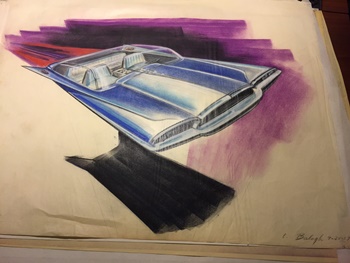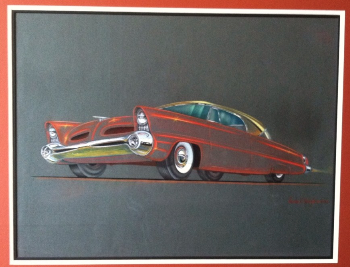Robert Edwards is a man on a mission with his collection of rare, signed studio concept-car designs that capture Detroit’s golden age of automotive styling from 1946-1973.
Edwards refers to the body of work as “industrial art on wheels,” that he believes played an important role in American history.
One of his many goals is to one day see this important collection hang in its own gallery at the Detroit Institute of Arts.
He points to the Toledo Museum of Art’s permanent exhibit honoring the city’s glass industry and the Art Institute of Chicago’s galleries honoring the city’s legacy of architecture as similar examples.

But Edwards’ immediate focus is on raising $60,000 needed to continue to find the car designers still around today and to record their oral history.
It’s all part of a feature-length documentary film he is co-producing with friend Greg Salustro called “American Dreaming.”
Edwards says to date he has 35 hours of interviews, and he now requires an infusion of funds to continue conducting the oral histories and to help cover the cost of post-production work on the film.
So far, he has raised $5,000 through a social-media fundraising site, but he’s hoping to find at least one big sponsor to see the project through.
Edwards says he and Salustro, both native Detroiters, long have been fascinated by these car stylists and their work and want to share what they learn with fans of graphic art everywhere.
Edwards estimates no more than 10,000 such sketches are still in existence, saved by the artists before the studios could destroy them for competitive reasons. And only a small number of the stylists are still around to talk about what it was like to work during this classic era.
Edwards recently played a portion of his impressive documentary on his iPad for me on the sidelines of a show featuring his collection at Lawrence Technical University’s College of Architectural Design in Southfield, MI.

Earlier in the week, he says, many retired automotive designers were in attendance.
Edwards, who curated the exhibition that runs through May 2, says the idea was to draw attention to the auto industry’s artists and craftsmen of the time, with the hope of creating public interest in the documentary project.
Pursuing his goals clearly is a labor of love for Edwards, who is not getting paid for the hours spent hunting through antiques shops, flea markets and garage sales hoping to find a prized design rendering.
It is the intrinsic value and not the monetary investment that matters, he says. Cars are part of the American culture, he says with a sly smile. “Who didn’t make out in a car?”
What I find fascinating about Edwards’ narrative is the impact the booming post-World War II era had on the American automotive industry. Before then, car designs were refreshed incrementally, such as a revamp of the fascia, backend or door section.
But in the halo years following the war, styling became highly valued by the automakers, and newly hired university-trained artists had the opportunity to shape the industry for generations to come.

Only later did they realize their work belonged to their employer. Once the project was finished and model year was completed, many car stylists were let go and their renderings never were seen again.
Only those clever enough to find a way to take some of their work with them had something to show for their efforts. Indeed, Edwards estimates more than 90% of the sketches of the period were destroyed.
One stylist, whose Studebaker rendering is on exhibit at Lawrence Tech, makes this point in her 1985 reminiscence of the era as given to Dave Crippon of the Edsel Ford Design History Center at The Henry Ford Museum.
Aubrey Moore Hodges, who died in 1996, is recognized as the first full-time woman automotive designer for a major American automaker.
Hodges graduated in 1943 from the University of Michigan’s industrial design program. She also worked as a draftsman during the war at the nearby B-24 bomber plant in Willow Run, according to her account.
In 1944, she was hired by Virgil Exner, later credited with the Forward Look design employed by Chrysler from 1955 through 1961, as a stylist at Raymond Loewy’s Studebaker style group in South Bend, IN.
Hodges designed a torpedo hood ornament and interior and exterior components for the ’47 Studebaker Champion.
In 1946, the automaker announced it had “made enough finished designs and models for a good 10 years,” and released the Loewy designers. Hodges left without ever knowing what, if any, of her work was used.
In 1947, she was hired by Automotive Hall of Famer Alex Tremulis to work in Chicago on interiors for the ’48 Tucker, of which only 51 were produced before Preston Tucker’s production line was shut down.
“And even though I had many sketches, and I’d saved my sketches,” she is quoted in her account to Crippon, “they all went to the Coppola studio, so I don’t have anything anymore.”
Director Francis Ford Coppola chronicled Tucker and his pioneering automobile in a 1988 film.
Edwards says most car designers of the era never got the recognition they deserved. He is hoping it’s not too late, with plans to finish his documentary next year.

